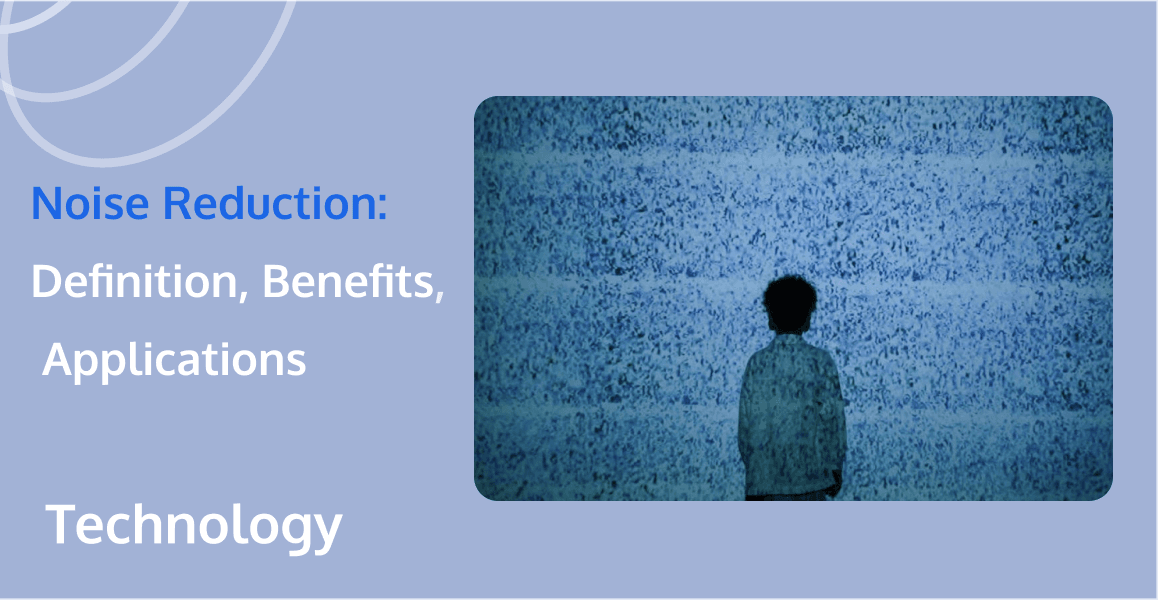
Noise reduction, a concept increasingly gaining traction, offers a solution to mitigate unwanted sounds across various domains. Reducing noise is the key to elevating your experience no matter whether for professional meetings, content creation, or personal communication.
In this blog post, we'll explore its definition, delve into its myriad benefits, and uncover the diverse applications it offers across different fields. If you're curious to unlock the secrets behind clearer audio, and smoother video calls, you've come to the right place. Let's dive in and discover the transformative power of noise reduction technology.

What Is Noise Reduction?
Noise reduction is a fundamental technique employed to minimize or eliminate unwanted noise from a signal or environment. It encompasses various methods aimed at enhancing the quality and clarity of desired audio, visual, or communication outputs.
Passive noise reduction involves physical barriers or insulation to block or absorb unwanted sound waves, while active noise reduction utilizes electronic systems to cancel out noise in real-time. These approaches are complemented by digital noise reduction techniques, which leverage advanced algorithms to selectively filter out noise while preserving the integrity of the signal.
Overall, noise reduction plays a crucial role in improving the fidelity and intelligibility of signals across different applications, from audio recordings to video conferencing. By effectively managing noise, these techniques enhance user experience and optimize the performance of technological systems in diverse settings.
Techniques for Noise Reduction
To better understand the science of noise reduction, let’s continue exploring the different noise reduction techniques. From passive methods that address noise at its source to sophisticated digital algorithms, each approach plays a crucial role in improving audio quality.
Passive Noise Reduction
Passive noise reduction includes techniques that diminish unwanted sounds without the need for additional power or electronics. This method often relies on physical barriers or materials to absorb or block noise. Common examples include soundproofing walls, using acoustic panels, and employing noise-canceling earplugs or headphones.
Active Noise Reduction
Active noise reduction employs electronic systems to counteract unwanted sounds in real-time. These systems use microphones to capture ambient noise, and then generate sound waves with opposite phase to cancel out the noise. Active noise-canceling headphones and microphones are prevalent applications of this technique, providing users with a quieter environment for enhanced listening or recording experiences.
Digital Noise Reduction
Digital noise reduction utilizes advanced algorithms and signal processing techniques to identify and suppress unwanted noise in digital audio or visual signals. By analyzing the characteristics of noise patterns, digital noise reduction algorithms can selectively attenuate noise while preserving the integrity of the desired signal. This technique is commonly employed in audio recording, video processing, and telecommunications to improve signal clarity and reduce background noise.
Adaptive Noise Reduction
Adaptive noise reduction techniques dynamically adjust noise reduction parameters based on changing environmental conditions or signal characteristics. These methods often employ machine learning algorithms or adaptive filtering techniques to continuously optimize noise reduction performance. Adaptive noise reduction is particularly effective in environments with variable noise profiles or complex signal-to-noise ratios, ensuring consistent noise suppression while minimizing artifacts or signal distortion.
Benefits of Noise Reduction
Reducing noise offers a plethora of benefits across various domains:
- Improved Signal Quality: By minimizing unwanted noise, noise reduction techniques enhance the clarity and fidelity of signals, whether it's audio recordings or communication channels.
- Enhanced Communication: Noise reduction facilitates clearer communication by reducing background noise in audio or video conferencing, ensuring that essential information is transmitted accurately and effectively.
- Increased Productivity: In environments where noise is a distraction, such as offices or public spaces, noise reduction fosters a conducive atmosphere for concentration and productivity.
- Enhanced User Experience: In consumer electronics, such as headphones or cameras, noise reduction enhances the overall user experience by providing clearer audio output or sharper images, leading to higher customer satisfaction.
- Optimized Performance: By minimizing interference from external noise sources, noise reduction improves the performance of devices and systems, ensuring reliable operation in various conditions.
Applications of Noise Reduction
Noise reduction techniques are applied across diverse sectors, enhancing audio clarity, improving communication systems, and refining data analysis. In this section, we'll delve into how noise reduction techniques are used in different areas to enhance the quality of output and improve user experiences.
Noise Reduction in Audio Recording
In the realm of audio recording, noise reduction plays a crucial role in enhancing the quality of recordings. Whether capturing vocals, musical instruments, or ambient sounds, minimizing background noise ensures clarity and fidelity in the final audio output. Advanced noise reduction techniques are employed to isolate desired audio signals while attenuating unwanted noise, resulting in cleaner recordings with improved intelligibility.
Noise Reduction in Video Conferencing
In video conferencing, noise reduction technologies are essential for ensuring clear audio quality during virtual meetings. Many conference platforms today come equipped with video noise reduction features to minimize distractions from ambient sounds, keyboard typing, or microphone feedback, allowing participants to focus on the conversation. Additionally, for those looking to build their own platform, integrating API solutions like Tencent's Video Chat can offer similar noise reduction capabilities. This technology can achieve crystal-clear audio transmission, enhancing user engagement by reducing background noise and other audio distortions in virtual meetings.
Noise Reduction in Voice Chatting
In the gaming world, the clarity of voice chat can significantly impact the overall experience, especially in multiplayer and competitive settings. Integrating noise reduction technologies directly into games enhances real-time communication among players, eliminating the need for separate voice chat applications.
Conclusion
In conclusion, this article has provided you with a comprehensive understanding of noise reduction, including its techniques and applications, so you will know how noise reduction enhances audio, and video conferencing, enabling clearer communication and more effective outcomes. Mastering these techniques can significantly improve your experiences in various contexts, underscoring the value of noise reduction in modern technology and communication.
If you have any questions or need assistance, our support team is always ready to help. Please feel free to contact us or join us in Telegram.
FAQs
How Does Noise Reduction Work?
Noise reduction works by employing various techniques to minimize or eliminate unwanted sounds from audio recordings or video streams. These techniques include passive noise reduction, which relies on physical barriers to block noise, and active noise reduction, which uses technology to cancel out unwanted sounds. Digital noise reduction algorithms analyze audio or image data to identify and remove noise digitally. Adaptive noise reduction adjusts settings dynamically based on the changing noise environment to ensure optimal results.
Is Noise Reduction Worth It?
Yes. Noise reduction technology, especially in headphones and audio equipment, is worth considering for several reasons. It significantly enhances the listening experience by filtering out ambient noise, allowing you to focus on the audio without increasing the volume to harmful levels. This can be particularly beneficial in noisy environments, such as airplanes or busy offices, improving concentration and reducing stress. Moreover, for audiophiles and those who use headphones for extended periods, noise reduction can help prevent hearing damage by enabling lower volume listening.


